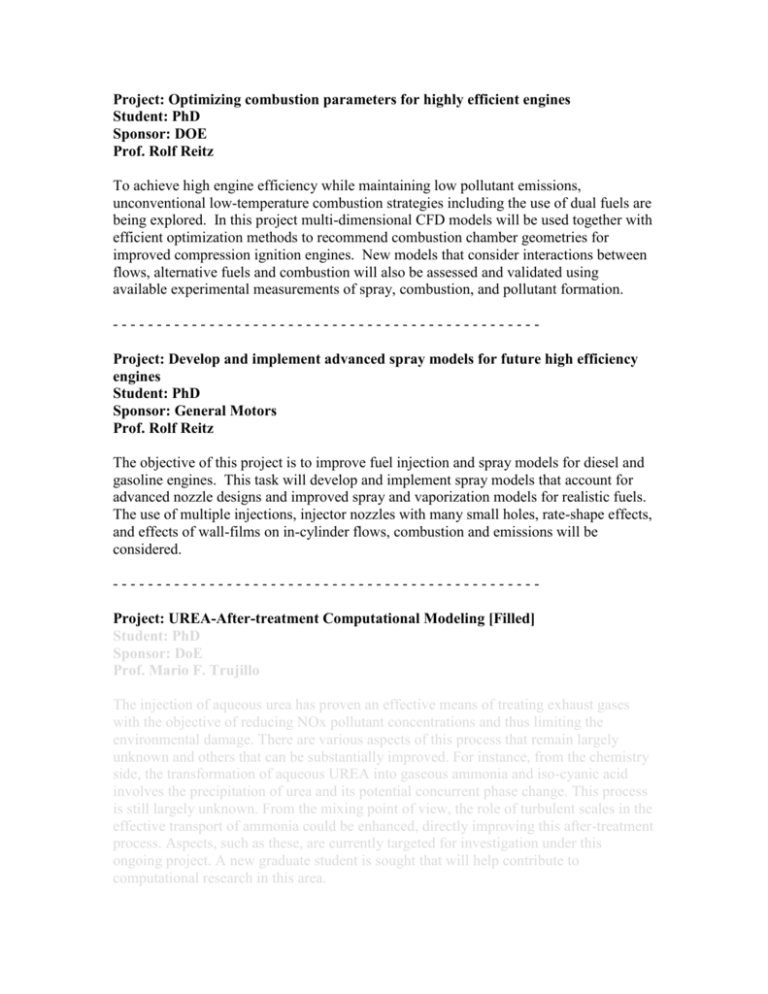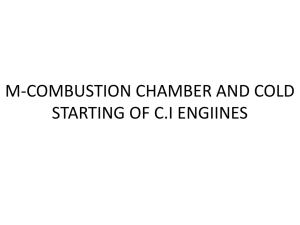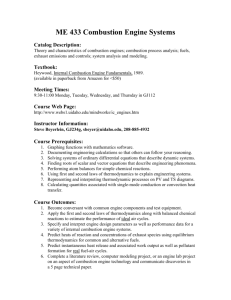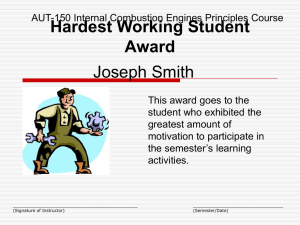Project: Optimizing automotive diesel engine in
advertisement

Project: Optimizing combustion parameters for highly efficient engines Student: PhD Sponsor: DOE Prof. Rolf Reitz To achieve high engine efficiency while maintaining low pollutant emissions, unconventional low-temperature combustion strategies including the use of dual fuels are being explored. In this project multi-dimensional CFD models will be used together with efficient optimization methods to recommend combustion chamber geometries for improved compression ignition engines. New models that consider interactions between flows, alternative fuels and combustion will also be assessed and validated using available experimental measurements of spray, combustion, and pollutant formation. ------------------------------------------------Project: Develop and implement advanced spray models for future high efficiency engines Student: PhD Sponsor: General Motors Prof. Rolf Reitz The objective of this project is to improve fuel injection and spray models for diesel and gasoline engines. This task will develop and implement spray models that account for advanced nozzle designs and improved spray and vaporization models for realistic fuels. The use of multiple injections, injector nozzles with many small holes, rate-shape effects, and effects of wall-films on in-cylinder flows, combustion and emissions will be considered. ------------------------------------------------Project: UREA-After-treatment Computational Modeling [Filled] Student: PhD Sponsor: DoE Prof. Mario F. Trujillo The injection of aqueous urea has proven an effective means of treating exhaust gases with the objective of reducing NOx pollutant concentrations and thus limiting the environmental damage. There are various aspects of this process that remain largely unknown and others that can be substantially improved. For instance, from the chemistry side, the transformation of aqueous UREA into gaseous ammonia and iso-cyanic acid involves the precipitation of urea and its potential concurrent phase change. This process is still largely unknown. From the mixing point of view, the role of turbulent scales in the effective transport of ammonia could be enhanced, directly improving this after-treatment process. Aspects, such as these, are currently targeted for investigation under this ongoing project. A new graduate student is sought that will help contribute to computational research in this area. ------------------------------------------------- Project: Fuel Neutral Particulate Study Student: MS or Ph.D. Sponsor: GM Prof. Dave Foster New regulations on the total particle number that may be emitted from a vehicle will go into effect soon. Gasoline engines, which have no difficulty meeting a mass based regulation, will be challenged to meet the particle number standard. This is especially true for direct injection gasoline engines, which will be used extensively to meet the new fuel economy standards. In this work a gasoline direct injection engine will be run under different conditions, with different fuels, and measurements of the particulate number and size distribution leaving the engine, as well as other emissions, will be made. The objective of the research is to assess the particle size and number distribution for a range of operating conditions and develop an understanding of the phenomena responsible for their formation in-cylinder. The research is already underway and this project is a continuation of the program. The engine and instrumentation already exist in the laboratory. The particulate emission from the engine is very sensitive to minor variations in engine operation and measurement of the particulate requires very specific well controlled sampling protocols. ------------------------------------------------Project: Fuel Composition, Combustion Mode and Engine Type Effects on Particulate Characteristics Low Temperature Combustion in a Single Cylinder Research Engine Student: MS or Ph.D. Sponsor: GM Prof. Dave Foster The number of particulates emitted from engines will be regulated on European vehicles and is proposed for regulation on US vehicles. Combustion and engine technologies that will be implemented to reduce fuel consumption, such as diesel engines, direct injection spark ignition engines along with the use of low temperature combustion will be challenged to meet the proposed particulate number regulations. The focus of this project will be to make detailed measurements of the number and size distribution as well as the physical and chemical characterizations of the particulate matter emitted from different engines operating with different fuels. This will be accomplished by augmenting the data taking for two on going projects. In one project we are exploring the LTC operation of a direct injection compression ignition engine with a range of fuels (gasoline-like to diesel-like, including bio-diesel). In the other project we are evaluating the particulate number emission for a gasoline direction injection engine. The objective of this research project will be to make particulate number and compositional measurement for these different engines and evaluate the similarities and differences in the emitted particulate for these different engines, operating in different combustion modes for a range of fuels. These data will be interpreted in terms of its implications for meeting number based particulate standards and approaches that may be pursued to reduce the number of particles emitted from the cylinder. ------------------------------------------------Project: The Study of LTC and Combustion Mode Switching During Engine Transients Student: MS Sponsor: DOE Prof. Dave Foster Low temperature combustion (LTC) is being studied extensively on single cylinder research engines operating under steady state conditions. When these combustion regimes are integrated into production, it will be necessary to operate in a multi-cylinder engine. Furthermore, the engine will be operating over transient cycles and it will be necessary to switch between conventional combustion and LTC and back. Studying the behavior of a multi-cylinder engine operating in LTC mode, and undergoing transients and/or combustion mode changes is the focus of this study. The multi-cylinder engine being used in this research has low-pressure and high-pressure EGR loops, a variable geometry turbocharger and a flexible common rail injection system. Successful transient operation of the multi-cylinder engine during combustion mode switches, or during transient LTC operation, will require a fundamental understanding of the impact of the time responses of the engine’s air handling, fuel injection and EGR systems and how they interact collectively with LTC operation or combustion mode change. This project is currently underway and supports two students. One of the students is graduating. This position will replace that student. ------------------------------------------------Project: Fundamental Investigation of Soot Formation in High-Pressure Flames with Real Liquid Fuels Student: MS or PhD Sponsor: ACS Prof. Dave Rothamer Soot is an important criterion pollutant species emitted by modern internal combustions engines. Most fundamental data on soot formation in flames is available only for atmospheric pressure conditions which are not representative of conditions in practical power generation devices (piston IC engines, gas turbines, etc.). Additionally, most data is for simple gaseous fuels, whereas most practical devices use liquid fuels derived from petroleum. To obtained measurements at relevant conditions a high pressure burner facility capable of operation on vaporized liquid fuels will be designed and built. The facility will be used to characterize the dependence of soot formation at high pressures on fuel chemical structure through the application of advanced laser diagnostics. ------------------------------------------------- Project: Knock Detection and Characterization in an SI Engine Student: MS or PhD Sponsor: Mercury Prof. Jaal Ghandhi Knock is the critical limiting factor of spark-ignition engine performance. This project aims to understand the causes and characterization of knock based on experimental measurements. A three-cylinder outboard marine engine that has been installed and instrumented in our laboratory for this purpose. There are two thrust areas of this project. First, an extensive survey of knock detection strategies will be performed using the measured cylinder pressure. This will be focused on developing a statistically converged description of the knocking process. The second thrust area will be the development of a system that can rapidly identify the knock intensity using pressure, ion or acceleration sensing. The goal for this system is to prevent engine damage during calibration in an automated test cell. ------------------------------------------------- Project: In-cylinder Investigation of Engine Size-Scaling Phenomena [Filled] Student: PhD Sponsor: Wisconsin Small Engine Consortium Prof. Jaal Ghandhi Two optical engines that are geometrically similar, with a length scale ratio of 1.7:1, have been built to study the effect of engine size scaling on the turbulent flowfield of an engine. Testing is currently underway to measure the velocity field using particle image velocimetry (PIV) and the scalar mixing field using planar laser-induced fluorescence. The operating conditions necessary to get similar behavior are being investigated under motored engine operation. In this project, further measurements will be made of the motoring flowfield, and the engines will also be fired to allow a comparison of the combustion performance and flame topography, both of which depend on the underlying turbulent flowfield. -------------------------------------------------







